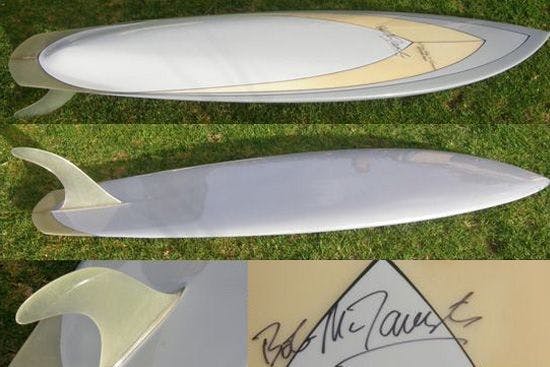Surf culture, SurfboardsThe Preservationists

by Mat Arney
Yesterday (Tuesday Oct 21st, 2014) saw one of the most extensive private collections of vintage and collectable surfboards in the southern hemisphere go under the auctioneers hammer in Perth, Western Australia.
The lot included over one hundred surfboards of historical significance, ranging from early hollow wooden paddleboards and balsa chips, through classic Malibu boards to transition era shortboards and beyond, right up to modern day high performance thrusters owned by WCT competitors. Some of them have been restored, but many of them are in original, often mint, condition. It’s an instant “buy it now” surf museum for those wit h deep enough pockets and has caused a stir amongst vintage surfboard collectors and enthusiasts – and it’s only a selection of the vendors total collection.

So, why would you want to own a sixteen foot long, 1946 Catalina Equipment Co. Tom Blake paddleboard, a mid-seventies 8’6” Dick Brewer gun or a 1980 six foot single fin shaped by Michael Peterson? One word: Provenance.
As surfing, as an activity, culture and sport matures, our appreciation for what went before and led us to our current state grows. When something is in it’s early and developmental stages there aren’t so many people participating, and the rapid development in materials and designs leads to many cast off and disregarded experiments. These are often rare, and it is only in due time that they come to be valued for what they truly are, which is examples of stages in the development of something special. The same is true for many things; items only realize their true value when enough time has passed for them to be appreciated as “vintage” rather than as obsolete, as they may have been regarded when an improvement originally arrived on the scene.

Surfing has now reached that age whereby vintage surfboards are becoming more collectable and also, with the passing of time, evermore rare. Surfboards are functional items designed with a set purpose, and many early surfboards have simply not survived. Others are lost; stored away in rafters or at the back of garages or worse yet slowly yellowing behind the weeds at the bottom of the yard. Old surfboards in good condition are, sadly, rare. That’s not to say however, that if you own a fine old example it shouldn’t see the sea every once in a while. It should. It’s what it was designed for and what its shaper would no doubt wish for it. Just don’t then leave it out in the sun and the rain at the bottom of your yard.

So, whilst many of us will only be window shopping online at Richard Hadley’s surfboard collection on the McKenzies Auctioneers website, there is no reason why we can’t provide a home for a piece of surfing history next time we pass by a garage sale. Just because a surfboard isn’t right at the cutting edge of design and performance it no longer means that it’s worthless. There are far stranger things that people choose to hoard, and an old surfboard can give you yet another good excuse to get in the sea.